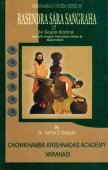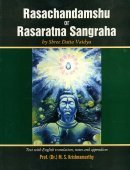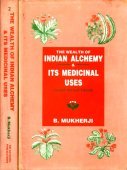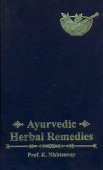Amavata, Āmavāta, Ama-vata: 14 definitions
Introduction:
Amavata means something in Hinduism, Sanskrit, Marathi, Hindi. If you want to know the exact meaning, history, etymology or English translation of this term then check out the descriptions on this page. Add your comment or reference to a book if you want to contribute to this summary article.
In Hinduism
Ayurveda (science of life)
Rasashastra (Alchemy and Herbo-Mineral preparations)
Source: Wisdom Library: Rasa-śāstraĀmavāta (आमवात) refers to “gout and rheumatism” according to the fifth volume of the Rasajalanidhi (chapter 26). Accordingly, “If persons of low digestive power happen to take, generally, articles of food-stuff, injurious by combination, resort to unhealthy activities ([...]), remain idle, take physical exercise ([...]) just after taking food cooked or mixed with fatty substance, the ama or undigested part of the chyle is carried away by the vayu or wind (growing increasingly in the stomach in the shape of gas due to fermentation of food) and deposit at places where phlegm is accumulated. The ama is thus putrefied in contact with the phlegm and is then carried through the arteries. This makes the ama again come in contact with vayu, pitta, and kapha, and tarn more putrefied. It pollutes, then, the fluid-carrying passages, assumes various colours, turns slippery, and causes weakness and heaviness of the heart. It is the root-cause of several diseases, and is not easily to be destroyed. In case the two things stated above, viz. ama and vayu, get turbulent, they simultaneously enter into the inner part of the hip-joint or causes numbness in some parts of the body, giving rise to what is called amavata or rheumatism”.
Unclassified Ayurveda definitions
Source: Google Books: Ṣoḍaśāṅgahṛdayam: Essentials of AyurvedaĀmavāta (आमवात) refers to “rheumatoid arthritis”.—The aggravated vāta carrying āma with it reaches and gets located in all the sites of kapha exhibiting pain, swelling and fever. This is known as ‘āmavāta’.
Source: archive.org: Science And Technology In Medievel India (Ayurveda)Āmavāta (आमवात) refers to “constipation” or “torpor of the bowels with flatulence and intumescence” and is one of the various diseases dealt with in the Dhanvantarīyapathyāpathya, as is mentioned in A. Rahman’s Science and Technology in Medievel India: A bibliography of source materials in Sanskrit, Arabic and Persian.—Ancient and medieval India produced a wide range of scientific manuscripts and major contributions lie in the field of medicine, astronomy and mathematics, besides covering encyclopedic glossaries and technical dictionaries.—The Dhanvantarīyapathyāpathya deals with the treatment of various diseases [e.g., Āmavāta]. The word pathyāpathya classifies those elements as either beneficial or hurtful in disease.
Source: Easy Ayurveda: Carpal Tunnel Syndrome SymptomsAmavata is a term which is used to describe a symptom complex in Ayurvedic pathology which resembles the disease Rheumatoid Arthritis of the modern day. Some experts have also seen it in comparison with Gout. The disease manifests in 2 different forms. The first form (stage) is moreover a systemic representation or manifestation of the early disease process when the joints, bones and soft tissues of the body have not yet been afflicted. The second form (stage) is a progressive / progressed stage of a disease (Pravridda Amavata) wherein we can find the disease manifesting in its full form with both of its systemic and local components.
Source: Research Gate: Internal applications of Vatsanabha (Aconitum ferox wall)Āmavāta (आमवात) refers to “rhumetoid arthritis” (a chronic inflammatory disorder). Medicinal formulations in the management of this condition include 9 references of Vatsanābha usages. Guṭikā is maximum (7) dosage form in the management of Āmavāta. Vatsanābha (Aconitum ferox), although categorized as sthāvara-viṣa (vegetable poisons), has been extensively used in ayurvedic pharmacopoeia.

Āyurveda (आयुर्वेद, ayurveda) is a branch of Indian science dealing with medicine, herbalism, taxology, anatomy, surgery, alchemy and related topics. Traditional practice of Āyurveda in ancient India dates back to at least the first millenium BC. Literature is commonly written in Sanskrit using various poetic metres.
Languages of India and abroad
Marathi-English dictionary
Source: DDSA: The Molesworth Marathi and English Dictionaryāmavāta (आमवात).—m (S) āmavāyu m (S) Chronic rheumatism proceeding from affection of the bowels.
Source: DDSA: The Aryabhusan school dictionary, Marathi-Englishāmavāta (आमवात) [-vāyu, -वायु].—m Chronic rheumatism caused by bowel affection
Marathi is an Indo-European language having over 70 million native speakers people in (predominantly) Maharashtra India. Marathi, like many other Indo-Aryan languages, evolved from early forms of Prakrit, which itself is a subset of Sanskrit, one of the most ancient languages of the world.
Sanskrit dictionary
Source: DDSA: The practical Sanskrit-English dictionaryĀmavāta (आमवात).—constipation, torpor of the bowels attended with flatulence and intumescence.
Derivable forms: āmavātaḥ (आमवातः).
Āmavāta is a Sanskrit compound consisting of the terms āma and vāta (वात).
Source: Cologne Digital Sanskrit Dictionaries: Shabda-Sagara Sanskrit-English DictionaryĀmavāta (आमवात).—m.
(-taḥ) Constipation or torpor of the bowels, with flatulence and intumescence. E. āma and vāta wind, the wind being supposed to be chiefly affected.
Source: Cologne Digital Sanskrit Dictionaries: Monier-Williams Sanskrit-English DictionaryĀmavāta (आमवात):—[=āma-vāta] [from āma] m. constipation or torpor of the bowels with flatulence and intumescence, [Suśruta]
Source: Cologne Digital Sanskrit Dictionaries: Yates Sanskrit-English DictionaryĀmavāta (आमवात):—[āma-vāta] (taḥ) 1. m. Constipation.
[Sanskrit to German]
Sanskrit, also spelled संस्कृतम् (saṃskṛtam), is an ancient language of India commonly seen as the grandmother of the Indo-European language family (even English!). Closely allied with Prakrit and Pali, Sanskrit is more exhaustive in both grammar and terms and has the most extensive collection of literature in the world, greatly surpassing its sister-languages Greek and Latin.
Hindi dictionary
Source: DDSA: A practical Hindi-English dictionary1) Amāvaṭa (अमावट) [Also spelled amavat]:—(nf) dried juice of ripe mango formed into thin cakes.
2) Āmavāta (आमवात) [Also spelled amavat]:—(nm) rheumatism.
...
See also (Relevant definitions)
Starts with: Ama-vatarokam, Amavatacikitsa, Amavatai, Amavatari, Amavateshvara.
Ends with: Antarayamavata, Bahirayamavata, Bhramavata, Kamavata.
Full-text (+5): Samdhishula, Ama-vatarokam, Phalatrikadi, Nirgundi, Shunthi, Caturbhadra, Rheumatoid arthritis, Amavateshvara, Vataviddhamsana, Phalatrikadilauha, Aparnaranjana, Vaneshvara, Amavatari, Vatagajendrasimha, Vriddhadaradya, Vatari, Candranathamodaka, Vatarirasa, Anilari, Ama.
Relevant text
Search found 3 books and stories containing Amavata, Āmavāta, Ama-vata, Āma-vāta, Amāvaṭa; (plurals include: Amavatas, Āmavātas, vatas, vātas, Amāvaṭas). You can also click to the full overview containing English textual excerpts. Below are direct links for the most relevant articles:
Jivanandana of Anandaraya Makhin (Study) (by G. D. Jayalakshmi)
Other Diseases < [Chapter 4 - Āyurvedic principles in Jīvanandana Nāṭaka]
Act VI (Summary) < [Chapter 3 - Summary of the Play Jīvānandana Nāṭaka]
Atharvaveda and Charaka Samhita (by Laxmi Maji)
Hārīta (Āyurveda scholar) < [Chapter 1 - Introduction]
Mādhavanidāna (Āyurveda book) < [Chapter 1 - Introduction]
Rasendrasāra Saṅgraha (Āyurveda book) < [Chapter 1 - Introduction]
Rasa Jala Nidhi, vol 5: Treatment of various afflictions (by Bhudeb Mookerjee)
Related products




